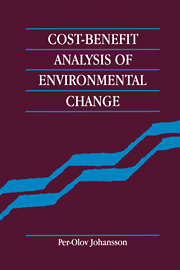Book contents
- Frontmatter
- Contents
- List of figures
- Preface
- 1 Introduction
- 2 Some basic concepts
- 3 Consumer surplus measures
- 4 Valuing public goods: practical methodologies
- 5 General equilibrium cost-benefit rules
- 6 Cost-benefit rules, national income accounts and sustainable development
- 7 Valuation and aggregation: intragenerational and intergenerational issues
- 8 Cost-benefit rules in a risky world
- 9 Valuing changes in access conditions, health risks and information
- 10 Empirical applications
- 11 Policy instruments and international environmental problems
- Notes
- References
- Index
7 - Valuation and aggregation: intragenerational and intergenerational issues
Published online by Cambridge University Press: 15 January 2010
- Frontmatter
- Contents
- List of figures
- Preface
- 1 Introduction
- 2 Some basic concepts
- 3 Consumer surplus measures
- 4 Valuing public goods: practical methodologies
- 5 General equilibrium cost-benefit rules
- 6 Cost-benefit rules, national income accounts and sustainable development
- 7 Valuation and aggregation: intragenerational and intergenerational issues
- 8 Cost-benefit rules in a risky world
- 9 Valuing changes in access conditions, health risks and information
- 10 Empirical applications
- 11 Policy instruments and international environmental problems
- Notes
- References
- Index
Summary
It is instructive to derive project evaluation rules for single-household economies using a general equilibrium approach. Many important valuation issues are best and most easily understood in such a context. This is why we have focused on single-household economies. Still, real-world economies are populated by many millions of households, some of which gain and some of which lose from any conceivable project. Similarly, some projects may have outcomes that affect those not yet born. Both of these problems have to be faced and somehow solved by anyone who wants to make statements about a project's desirability. This chapter takes a look at both the intragenerational and the intergenerational distribution issues without any pretension whatsoever to treat exhaustively all of the difficult problems involved. Hopefully, however, the chapter may provide some useful insights for applied cost-benefit analysis.
The chapter is structured as follows. Section 7.1 presents the concept of a social welfare function. In the subsequent section, the social welfare function is used to derive cost-benefit rules, and there is a focus on the possibility of summing monetary gains and losses across households. Section 7.3 discusses the possibility of interpreting the outcome of a social cost-benefit analysis in terms of the compensation criteria suggested by Hicks and Kaldor in the late thirties. The following section presents a couple of suggestions on how to deal with the aggregation issue in applied studies. Sections 7.5–7.7 are devoted to intergenerational aggregation issues. Since the aggregation across generations causes similar problems to aggregation within a generation, the presentation focuses on the choice of social discount rate when a project has long-term consequences.
Information
- Type
- Chapter
- Information
- Cost-Benefit Analysis of Environmental Change , pp. 113 - 132Publisher: Cambridge University PressPrint publication year: 1993
